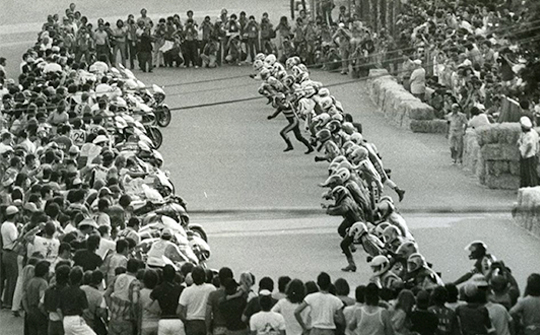This exhibition commemorated the legendary Montjuïc racing circuit, scene of some of the most important national and international motoring and motorcycling events.
The circuit, which was about four kilometres long, had two sections, a slow, technical descent, and a fast stretch. It placed great demands on the competitors’ skills and the sporting events staged offered great outdoor entertainment. Their closeness to the city centre ensured capacity crowds.
The exhibition explored the history of the circuit through the most famous races: the Barcelona International Grand Prix (later the Spanish Grand Prix), the 24 Hours of Montjuïc, and Formula 1, 2 and 3 events, races that were organized by entities such as the Moto Club de Barcelona, the Penya Rhin, the Royal Automobile Club of Catalonia (RACC) and Penya Motorista de Barcelona.
The epic races that took place on the Montjuïc circuit made it a legend. They combined speed and endurance, but there were also charity races, races with a special dose of spectacularity, and classic car parades. The circuit was used from 1932 until 1986, but it was in the 1960s when it really made a mark in the history of motor racing.
With the evolution of technology, the speeds achieved, especially by the cars, seriously jeopardized the security of the participants and the public, which meant that less and less races were organised at the venue and resulted in the definite disappearance of any kind of car-racing activity on the circuit in the mid 1980s.
The spirit of Montjuïc, however, is alive and kicking. Under the same name, an motoring and motorcycling event is organized every year at the Montmeló race track with the aim of evoking the excitement experienced by the drivers and riders, organizers and public who were able to enjoy the spectacular races and the roar of the engines.
Neighbours living at the foot of the hill still remember how the noise of the races resounded inside their homes. Many of them used to go to the circuit, with those without tickets standing on the bends and feeling very close to the thrill of the races.
Organization
Institut de Cultura, Ajuntament de Barcelona
Concept layout, design, production and assembly
MagmaCultura
Scientific advise
Javier Gil i Manel Maestro; Penya Motorista de Barcelona
Proofreading and translations
Incyta Multilanguage
With the collaboration of
Penya Motorista de Barcelona
Lended works
Col·lecció d’Automòbils Salvador Claret i Pere Tarragó
Archives
Biblioteca de l'Esport de la Generalitat de Catalunya, Arxiu Fotogràfic de Barcelona, Penya Motorista de Barcelona i Hemeroteca de la Vanguardia
© of images
Josep Aragall, Família Javier del Arco, Família Babler, Martí Bas Blasi , Puig Farran Manuel Garriga, Antonio Palacín, Jordi Plana, Jaume Poch, Pérez de Rozas, Josep Maria Sagarra, Pau Lluís Torrents i José Ma Gil-Vernet
Insurance
Hiscox Europe
Acknowledgements
Josep Aragall , Família Babler, Josefina Cristiá, Javier Gil, Manel Maestro, Antonio Palacín, F. X. Permanyer, Jordi Plana, Jaume Poch, Pere Tarragó i Josep Ma Gil-Vernet





